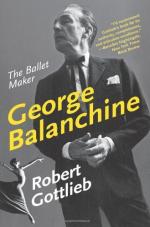|
This section contains 198 words (approx. 1 page at 300 words per page) |
The greatest choreographer of the twentieth century, George Balanchine transformed and modernized the classic tradition of Russian ballet. A graduate of the imperial St. Petersburg ballet academy, he left Russia in 1924 and soon became the resident choreographer for Diaghilev's Ballet Russes. Brought to the U.S. by the wealthy young impresario, Lincoln Kirstein, in 1933, together they founded the School of American Ballet and later, in 1948, the New York City Ballet. Until 1948 Ballanchine choreographed a number of successful Broadway musicals and Hollywood movies. Eschewing traditional ballet story lines, Balanchine created a series of unprecedented masterpieces, his "black and white" ballets—so called because the dancers wear only their practice clothes—Apollo (Stravinsky), Agon (Stravinsky), Concerto Barocco (Bach), The Four Temperaments (Hindemith), and Symphony in Three Movements (Stravinsky). They share the stage with rousing and colorful dances based on folk and popular music like Stars and Stripes (John Philip Sousa), Western Symphony, and Who Cares? (Gershwin).
 George Balanchine (center), working with a dancer.
George Balanchine (center), working with a dancer.
Further Reading:
New York City Ballet. The Balanchine Celebration (video). Parts I and II. The Balanchine Library, Nonesuch Video, 1993.
Taper, Bernard. Balanchine: A Biography. Berkeley, University of California Press, 1984.
|
This section contains 198 words (approx. 1 page at 300 words per page) |


